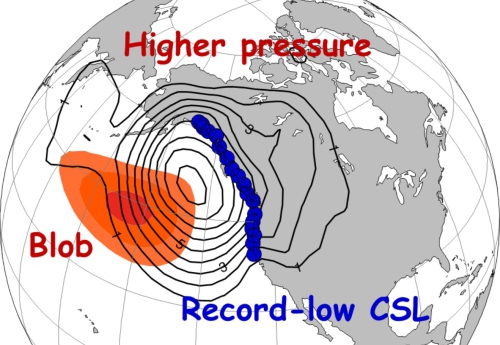For the coastal regions surrounding the Pacific basin where human activities are concentrated and landmass erosion and inundation can exert most impact, it is the regional sea level variability that is of paramount importance. In the past three decades, coastal sea levels (CSL) in the Northeast (NE) Pacific shows a near-zero or even decreasing trend in sharp contrast to the global mean sea level rise.
"Most of studies were concerned about the CSL trends in the NE Pacific over the past three decades, but extreme year-to-year changes have received less attention", said WANG Yaqi, a Ph.D. candidate in the State Key Laboratory of Numerical Modeling for Atmospheric Sciences and Geophysical Fluid (LASG), at the Institute of Atmospheric Physics, Chinese Academy of Sciences.
"While many coastal regions worldwide recently experienced record-high CSL, record-low CSL was reached in the NE Pacific during the winter of 2013-2014. This large drop was a once-in-a-century event and closely related to the Blob (the unusual ocean warming", introduced WANG.

Anomalies of sea level pressure (hPa; contour) and sea surface temperature (°C; shading) for the winter of 2013-2014. The blue dots represent the locations of the record-low coastal sea levels. (Image by WANG Yaqi)
In a recent study published in the Scientific Reports, WANG Yaqi and her supervisor Prof. LIU Hailong cooperated with Prof. YIN Jianjun of University of Arizona systematically investigated the cause for this record-low CSL anomaly and the role of large-scale climate modes.
The team analyzed three most commonly available sea level datasets: the merged satellite altimetry data (AVISO), an ocean reanalysis data (GODAS) and the in-situ Tidal Gauge (TG) measurement to identify the variability of wintertime sea level along the coast of NE Pacific. They found all three datasets show the lowest CSL anomalies during the winter of 2013-2014. The most pronounced CSL drop associated with this event can be found in the TG data, in which the TG_N CSL anomaly decreased to -107 mm, much larger than that for AVISO (-52 mm) and GODAS (-68 mm). "The difference of the three datasets can be due to the fact that the TG data is a point measurement at the coast while AVISO and GODAS gridded data are area averaged near the coast and outside the primary zone of Ekman transport convergence that peaks along the coastline." WANG said.
Based on the analysis, WANG and her coauthors further identified the cause for this record-low CSL anomaly and the role of large-scale climate modes. Both the Blob and record-low CSL can be attributed to wind changes associated with an unusually high sea level pressure (SLP) pattern over the NE Pacific. The anomalous local longshore winds induced by the positive SLP anomalies caused strong offshore Ekman transport along the coast of NE Pacific, thereby leading to the record-low CSL. In addition, the steric sea level changes also contributed a significant part (17%) to the record-low CSL. The Pacific Decadal Oscillation (PDO), as the primary variability mode in the NE Pacific on decadal time scales, did not contribute to the emergence of this extreme CSL event.
This work expects help us to better understand the regional sea level change in the global warming context.
Citation: Wang, Y., Liu, H., Lin, P., & Yin, J. (2019). Record-low coastal sea levels in the Northeast Pacific during the winter of 2013–2014. Scientific Reports, 9(1), 3774. https://doi.org/10.1038/s41598-019-40397-w
Media contact: Ms. LIN Zheng, jennylin@mail.iap.ac.cn
